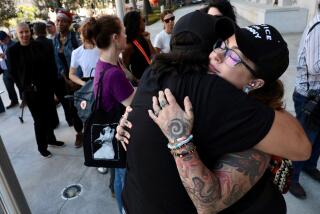DNA used to identify three suspects in car burglaries
- Share via
Los Angeles detectives used DNA evidence from downtown car burglaries to connect three men to separate crimes. Police have already taken one of the men into custody and are searching for the others.
Detectives decided to pursue the car burglars with technology more often used in murder and sexual assault cases because of the potential number of victims.
“This was an unexpected windfall,” said Police Lt. Paul Vernon, head of detectives at the Central Police Station. “Car burglars are among the hardest criminals to tie to crimes because few are ever seen, so to identify three from DNA like this is rare, but becoming more common.”
Vernon said detectives throughout the department are being careful to gather any physical evidence containing DNA at crime scenes, especially blood, saliva or other bodily fluids.
Two of the suspects -- Clifford Sutherland and Victor Garcia -- remain at large. Warrants have been issued for their arrest.
Blood left on a door handle identified Garcia, 28, of Los Angeles, as a match for a car burglar who smashed the window of a sports car parked near 4th and Hill streets in 2007 and removed cash, Vernon said. In another case, blood found on a paper bag left by a car burglar in 2008 was collected and placed in the laboratory queue for analysis. The blood was analyzed a year later and the results were added to a state database.
In May, database officials notified detectives that the blood belonged to Sutherland, 23, of Los Angeles. Vernon said Sutherland’s DNA was on file from a prior arrest. He is on probation for grand theft.
The third suspect, Ruben Vera, 43, of Lincoln Park, was arrested last week in connection with a February 2008 burglary in which a window was smashed and a stereo and CDs were stolen from a car parked on Jesse Street west of Santa Fe Avenue.
A lab analysis of blood recovered from the broken glass led detectives to Vera, who was on parole for burglary.
The use of DNA evidence in nonviolent crimes has been rare, due primarily to the expense.
That may change, however. A study completed last year involving the LAPD showed that when investigators recovered usable DNA samples from property crime scenes, a suspect could be identified in 45% of the cases.
“We’re very pleased to see these matches return, even after one year,” Vernon said.
“Car burglaries are a low priority compared to murders and sexual assaults, so those cases do and should take priority.”
Speaking of the state database, he said: “We’ll see more and more of these cases coming in as more criminals are entered and DNA collection becomes more commonplace.”
--
More to Read
Sign up for Essential California
The most important California stories and recommendations in your inbox every morning.
You may occasionally receive promotional content from the Los Angeles Times.











